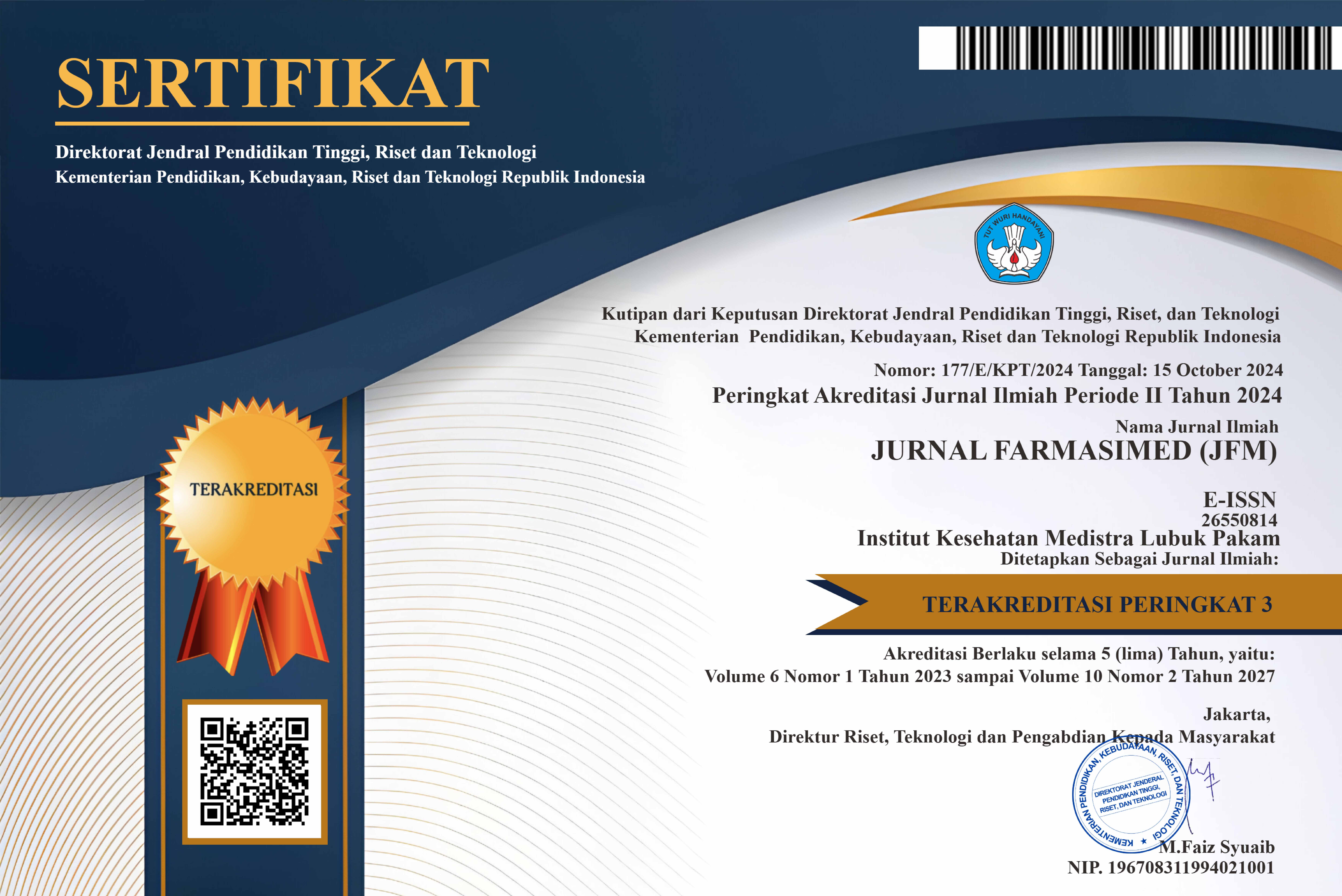FORMULASI SEDIAAN LOTION EKSTRAK ETANOL BIJI KOPI ROBUSTA (Coffea cenephora)
DOI:
https://doi.org/10.35451/jfm.v3i2.570Keywords:
Robusta coffee bean extract (Coffea canephora), lotionAbstract
Bean robusta coffee contains polyphenol compounds which are useful as antioxidants. Antioxidants can inactivate the development of oxidation reactions, by preventing the formation of free radicals. Robusta coffee bean plant (Coffea canephora) is an ingredient that can be formulated into lotion preparations. Cosmetic lotion aims to remove dead skin cells, brighten the skin and soften the skin. This research is to make lotion preparations from robusta coffee bean extract (Coffea Canephora) . This research uses pure experiment. Robusta coffee beans are extracted by maceration process. The lotion formulation is made with variations of robusta coffee bean powder (Coffea Canephora) with a concentration of 2%, 3%, and 4%. The characteristic test includes organoleptic test, homogeneity test, Ph test, and irritation test. The purpose of this study was to determine the lotion formulation for robusta coffee bean extract (Coffea Canephora). The results of the lotion test had a homogeneous concentration of 2%, 3% and 4%, light brown to blackish brown, with a distinctive smell of coffee. The ph lotion test had a PH of 5 in all formulations on the blank had a PH of 6. The irritation test on the lotion preparation showed no erythema and edema in 5 volunteers. From all the tests carried out, the lotion formulation has good characteristics.
Downloads
References
Ansel, H, C., (1989). Pengantar Bentuk Sediaan Farmasi, Edisi Keempat. Jakarta: Universitas Indonesia Press.
Ansel, H. C., (2005). Pengantar Bentuk Sediaan Farmasi. Edisi Keempat. Jakarta: Universitas Indonesia Press. Hal. 162-163, 357-389.
Clarke, R. J. dan R. Macrae. (1989). Coffe Chemistry. I dan II. Elsevier Aplated Science. London and New York.
Cronquist, A., (1981). An Intedgrated System Of Classifikation Of Flowering Plants, New York, Colombia. University Press. Hal. 477.
Ditjen POM. (1985). Formulasi Kosmetika Indonesia. Edisi Kelima. Jakarta: Depertemen Kesehatan RI. Hal. 22, 83, 96-97, 356.
Ditjen POM. (1995). Farmakope Indonesia. Edisi Kelima. Depertemn Kesehatan RI, Jakarta.
Ditjen POM. (2000). Parameter Standar Umum Estrak Tumbuhan Obat. Departemen Kesehatan RI. Jakarta: Hal. 3-5, 13-17, 30-31.
Erungan, A. C., S. (2009). Aplikasi Keraginan Dalam Pembuatan Skin Lotion. J. Teknologi Hasil Perikanan Indonesia. Hal. 128.
Fadhilah, R., (2018). Formulasi Krim Lulur Dari Ekstrak Rumput Laut dan Keragenan, Dapertemen Teknologi Hasil Perairan, Fakultas Perikanan dan Ilmu Kelautan, Institut Pertanian Bogor.
Farah, A. (2012). Coffee Constituens in Coffee. Emerging Health Effects and Reven Reventron. First Edition United Kingdom: Black Well Publishing Ltd.
Hanani. (2015). Analisis Fitokimia. Jakarta: EGC.
Haryanto. (2014). Asesmen Pendidikan. Bandun. PT Remaja Rosdakarya.
Hecimovic, L., Cvitanovic, A, B., D and Komes,D. (2011).Comperative Study. F Polyphenols and Caffeine In Diffcrent Coffe Varieties Effected By The Degree Of Roasting. Food Chemistry.
Hidayato, H. S, dan Karim, Z. (2013). Stabilitas Fisik Sediaan Lotion O/W dan W/O Ekstrak Buah Mahkota Dewa Sebagai Tabir Surya dan Uji Iritasi Primer Pada Kelinci. Hal. 109-117.
Karim, Dkk. (201 3).Stabilitas Sediaan Kosmetika Jurnal FMIPA Ilmiah. Hal. 86.
Kumalaningsih, S. (2006). Antioksidan Alami Penangkal Radikal Bebas. Surabaya: Trubus Agrisarana.
Lachman, L., dan Libermen, H. A., (1994). Teori dan Praktek Farmasi Industri, Edisi Kedua, UI Press, Jakarta.
Langseth, L., (1995). Antioxidant, and Desease Prevention, International Life Scrience Institute Press, Belgium.
Maharani, Ayu. (2015). Penyakit Kulit, Perawatan, Pencegahan, dan Pengobatan.Yogyakarta: Pustaka Baru Press.
Mutua, J. (2000). Post Harvest Handling and Processing Of Coffe in African Countries.
Najiyati dan Danarti. (2012). Kopi Budidaya dan Penanganan Lepas Panen. Jakarta, Indonesia.
Novi Pramuditha. (2016). Uji Stabilitas Fisik Lulur Krim Dari Ampas Kelapa (Cocos nuciferal L) Dengan Menggunakan Emulgator Anionik Dan Nonionik. Skripsi Farmasi. Fakultas Kedokteran Dan Ilmu Kesehatan. Universitas Negri Allaudin: Makasar.
Palacios, H. A., H. C. Menezes, B.T. Iamanaka, F. Canepa, A. A. Teixeira, N. Calvalheas, D. Santi, P. T. Z. Leme, K. Yotsuyanagi and M. H. Taniwaki. (2007). Efect of Temperatur and Relative Humiduty during Transportation on Green Coffe Bean Moisture Content and Ochratoxin A Production. Jurnal of Food Protection. 7(1): 164-171.
Pangabean, E. (2011). Buku Pintar Kopi. PT. Agro Media Pustaka. Jakarta. Prakash, A., Antioxidant Activity., Medallion Laboratories: AnalithycalProgres, (2001). Vol 19 No: 1-4.
Purba, R. Y. (2016). Skrining Fitokimia dan Penggunaan Buah Belimbing Manis (Averrhone Caranbola. L). Sebagai Pelembab Dalam Krim Cair Tangan Dan Badan. Medan. Universitas Tjut Nyak Dhien.
Ridwansyah. (2003). Pengolahan Kopi, Jurusan Teknologi Pertanian, Fakultas Pertanian. Universitas Sumatera Utara.
Rothfos, B. (1986). Coffe Production. Hambang: Gordian- Max- Rieck- GmbH.
Rowe, R. C et al. (2003). Handbook of Pharmaceutical Exeipient, 4th ed. Pharmaceutical Press.
Silalahi , J., (2006). Makanan Fungsional. Kaisius, Yogyakarta. Hal: 40-48.
Tranggono, RI. dan Latifa F. (2007). Buku Pangan Ilmu Pengetahuan Kosmetik. Penerbit Pustaka Utama. Jakarta, Indonesia.
Wasitaatmadja, S. M. (1997). Penuntun Iilmu Kosmetik Medik, Universitas Indonesia Press. Jakarta.
Wasitaatmadja, S. M.(2011). Ilmu Penyakit Kulit dan Kelamin. Edisi 6. Jakarta: Balai Penerbit FKUI.
Yoigh, R., (1995). Buku Pelajaran Teknologi Farmasi. Yogyakarta: UGM Press.
Downloads
Published
Issue
Section
License
Copyright in each article is the property of the Author.

























